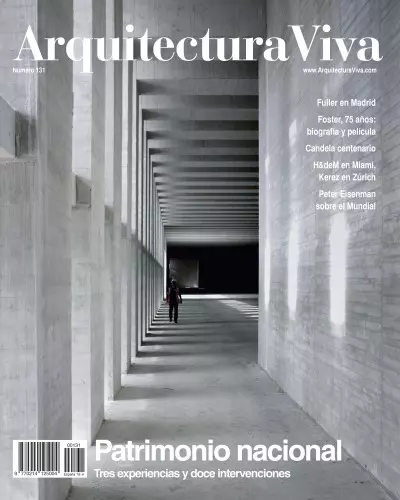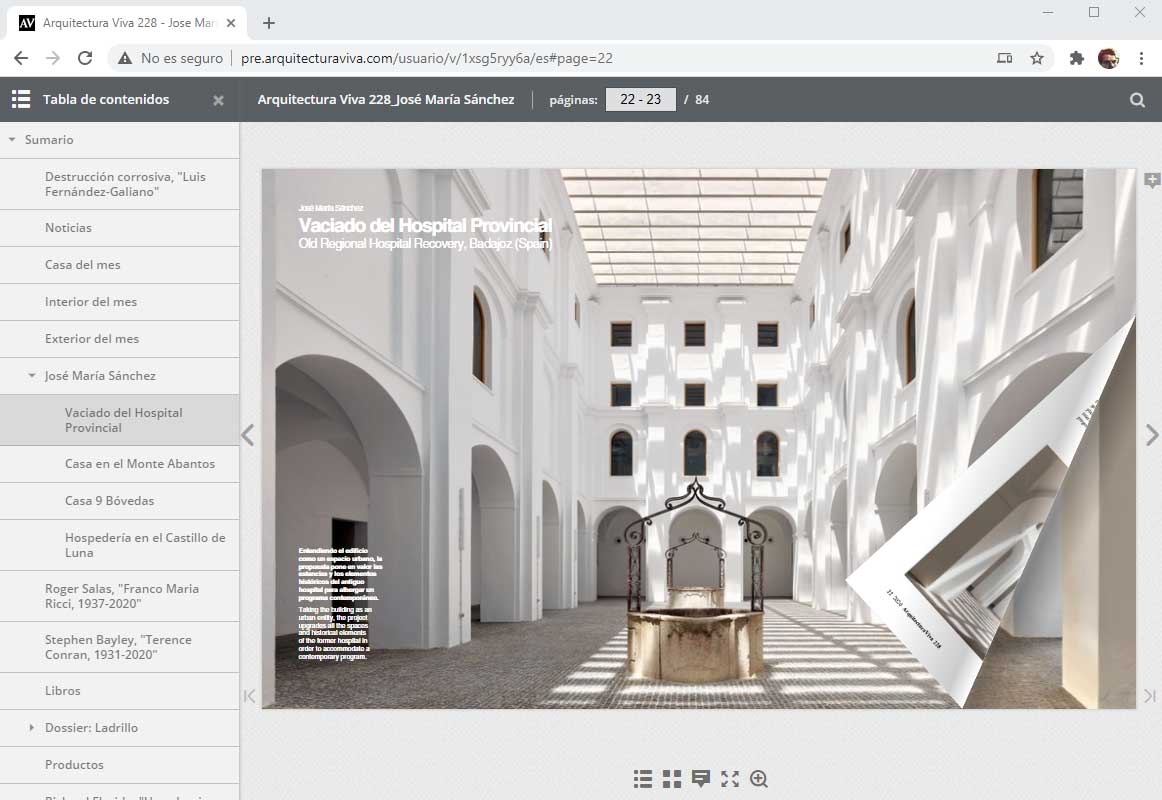Synopses
National Heritage. Extant buildings are civic assets. The monumental ones, reflection of the promoting institution, undergo interventions by which they are emptied, refurbished or extended. Three examples:?in Bilbao, the French Philippe Starck recovers the municipal Alhóndiga with a mixture of austerity and electicism, keeping its modernist shell;?in?Seville, Guillermo?Vázquez Consuegra converts the Palace of San Telmo, previously a university and a seminary building, into the seat of the Andalusian government; and in?Madrid, the studio Mansilla & Tuñón inserts a museum-wall in the basement of the Royal Palace.
Contents
Iñaki Bergera
Old Wine in?New Bottles
Alhóndiga, Bilbao
Víctor Pérez Escolano
Mutating Monument
Palace of San Telmo, Seville
Pedro Moleón
Great Containment
Royal Collections, Madrid
Interventions on Legacy. By alphabetical order of authors, the twelve works presented here combine past and present: the refurbishment of the
Tàpies Foundation in Barcelona;?a business incubator in an old factory in Llobregat; the native home of Núñez de Balboa converted into museum in Jerez de los Caballeros; the Atarazanas Market in Málaga, devoid of additions;?the space dedicated to Chillida in a paper factory in Legazpi; a cultural center of Caixa Sabadell in an old?School of Arts and Trades; a recycling exercise in the Matadero of Madrid;?a museum in a family estate in Salamanca; the transformation into viewpoint of the Torre del Homenaje in Huéscar; a museum of contemporary art amid Baroque neighbors in Alicante; a Museum of Water next to the Channel of Castile; and an intervention in the city wall of Logroño.
Ábalos & Sentkiewicz, Barcelona
Alonso & Balaguer, Esplugues
Amores & García, Badajoz
Aranguren & Gallegos, Málaga
Blancafort & Reus, Legazpi
Bonell & Gil, Sabadell
Arturo Franco, Madrid
Antón García-Abril, Salamanca
Antonio J. Torrecillas, Huéscar
Sancho y Madridejos, Alicante
Serrano y Vélez, Palencia
Ulargui y Pesquera, Logroño
Views and Reviews
Twin Souls. Bucky Fuller, a hard to label American genius, strongly influenced the work of Norman Foster; an exhibition at Ivorypress includes his Dymaxion Car no. 4, recreated by the British architect, who has just turned 75.
Art / Culture
Jorge Sainz
Dymaxion World
Jonathan Glancey
Norman’s Conquest
Madrid Centennials. The Residencia de Estudiantes, which had Le Corbusier among its lecturers, opened its doors in 1910; also one hundred years have gone by since the birth of Félix Candela, author of dozens of laminated roofs.
Salvador Guerrero
Master Lessons
Ricardo Aroca
The Self-Taught Builder
Built Patrimony. Françoise Choay reflects upon heritage; moreover, two researches on social housing; the cars of the recently deceased Bill Mitchell and of Foster; new texts on aesthetics; and also, books received.
Focho’s Cartoon
Spain in South Africa
Various Authors
BooksRecent Projects
Swiss Stacks. An exquisite parking building of several levels constructed of bare concrete, where cars mingle with luxury shops and spaces for events in Miami Beach, is the last American work by the Basel partnership; north of Zurich rises a school of triangulated structure, vertically distributed, rounded off by an open-plan gymnasium and enclosed with glass.
Technique / Style
Herzog & de Meuron
Graceful Chassis
1111 Lincoln Road, Miami
Christian Kerez
Metal Backstitches
Leutschenbach School, Zurich
To close, Peter Eisenman, a big fan of football (soccer for many in the United States) and American football, is also an enthusiastic follower of European broadcasts, and here he shares his impressions about the World Cup 2010 in?South Africa – where the Spanish team rose as winner – highlighting the Americanization of the game and his preference for direct experience.
Products
Seats, Facades
English Summary
National Heritage
Peter Eisenman
World Cup Broadcast
Luis Fernández-Galiano
National Heritage
If our only true homeland are the landscapes of childhood, our only heritage are the memories which serve as a support for our personal or collective identity. But our memory feeds not only on pale photographs, forgotten music or fading perfumes; it is also enhanced by the physical experience of the environments, buildings and places that have been the backdrop of life. Architecture is our madeleine of Proust, and protecting its works from the stubborn decay produced by time and neglect amounts to facing the deliberate oblivion of this lotus-eating culture, where social amnesia is combined with the fabrication of fictions, and where the ravages of entropy are lesser than the devastation caused by historical fakes.
Each generation rewrites its past, reinterprets its buildings with the interests of the present, and intervenes in obsolete architectures in order to adapt them to new uses. This regeneration of inherited constructions harbors an inevitable destructive component, because the surgery of the works cannot do without the scalpel, but in the majority of cases the loss is compensated for with an extension of the life cycle that is only possible with a stop by the operating theater. The nostalgia for the traces of neglect is as respectable as the feeling of indignation when venerable masonries are treated with invasive plastic surgery and therapeutic cruelty; but we cannot criticize the cautious medicine that extends and enriches life.
Until recently, the concept of heritage was linked only to very ancient or unique works, whose custody fell routinely on historians and archaeologists. Today, the extension of this label to an endless number of fields, from landscape or agriculture to engineering or industry, and its application to the most immediate past – including modern heritage, but also conventional urban contexts – transfers the emphasis from the conflictive ground of collective memory to the negotiable space of the everyday. In this way, while the iconic and memorable works are disputed between the political agents and the leisure industry, everyday heritage is recovered, refurbished and renewed as a source of usefulness and pleasure.
Built heritage, after all, is not just frozen memory. As much the monumental as the anonymous accrue the energy of its materials and its construction: a legacy that each generation receives from the previous one, and that must be managed sensibly, without letting the existing act as a rigid shell that prevents the growth of the social organism, but without allowing either this wealth go to waste with indifferent neglect or unnecessary destruction. Affluence has turned us into fanciful children that forget or break their toys to replace them with new ones, and we must show that spoiled generation how to remember, to refurbish and to reuse. These old toys are our heritage, and perhaps our homeland.








